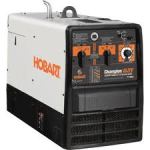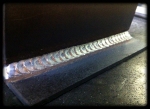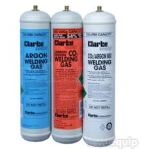A tap
cuts threads on the inside of a hole – known as FEMALE threads, to accept a machine screw or bolt. Taps can also be used to restore an internal thread
that has been damaged or to cut a new, larger thread in the case of severe damage or stripping.
The opposite of an internal thread is an external thread – MALE thread
which you can cut using a die
Taps come in 3 types – usually as a “set”, starting a first cut, middle or 2nd cut and lastly a bottoming or plug tap. 1st cut has the most taper and is design to start the thread in a new hole, 2nd has a bit less, bottoming will cut threads all the way to the bottom of a blind hole. You can usually get away with just 2nd and bottoming. If you are cleaning out a hole, I would use 2nd or plug tap because there is less risk of cross threading, which is easy to do in a mangled thread.
Dies on the other hand usually come as a Split Die – this is to allow the Die to be “opened out” to make the first cut on a round shaft easier to start (similar to a first cut tap), and then closed a little to finish the thread to a good fit to the nut or female thread.
So to recap a “TAP” is used to make a FEMALE or INTERNAL THREAD, a “DIE” is used to make a MALE or EXTERNAL THREAD.
A TAP needs a TAP HANDLE which clamps the “tap” in place in order to be able to manually turn the tap to produce the cutting action
These come in various forms, as above or
Both types are often called a “TAP WRENCH”
If we are going to put a female thread into a part we will need to know what size to drill the hole. In order to do this we must look this up on a “Tapping drill” chart see example below.

Tapping Drill Size table
A good idea for most engineers is to invest a couple of pounds into a ZEUS book which contains many “technical” charts / tables / formula that engineers require – they are worth every penny –
An extremely handy pocket sized reference booklet of data charts and tables for the drawing office, toolroom or workshop.
This metric revision publication is produced by Zeus Precision Charts Ltd, who are members of the British Standards Institution.
The 28 laminated pages contain data on standard drill sizes and decimal equivalents, tapping drills and clearances for metric and imperial threads, BS4500 tolerances, hardness comparisons, jig boring co-ordinates for equally spaced holes, allowances for sheet metal bending and Morse tapers.
Also, long tables for sine, cosine, tangents and cotangent.
Threading a hole is a skill, the tap has to be aligned with the hole and care needs to be taken to ensure that the thread stays aligned with the drilled hole otherwise you can end up with a thread running at an angle to the hole that has been drilled.
When tapping a standard right handed thread you must take great care to “break off” the swarf that is being cut from the inside wall of the hole. To do this we wind the tap in clockwise 1 turn at a time, stop and then turn back (anti-clockwise) 1/2 a turn. It is also a good idea to use some form of cutting compound to “ease” the process.
Great care must also be taken with consideration to force being used and resistance being felt through the tap handle. If there is excess swarf build up the the rotary motion of turning the tap becomes difficult and “tight”, this may also be true if no tapping / cutting fluid or compound is used and certainly if the hole has been drilled out too small. As the actual tap is made of hardened steel it is possible to break a Tap off in the hole you are tapping, particularly with smaller taps.
Automated tapping heads are available for pedestal drilling machines, these actually reverse the action before too much pressure is built up thus reducing the chance of breaking a tap.
More than likely though it is worth investing in a good quality Tap & Die set – Recommended is this DRAPER set – if looked after will last a life time.
Draper 79203 37-Piece Tap and Die Set
Click on image to take you to Amazon site
Product Description
We can repair threads in aluminium, mild steel, stainless steel & castings
SEE –
Don`t forget to email or call us for all your custom made 1 off bespoke items.
Thanks for reading our blog – we hope this has been of use to you.
Recommended sites












































